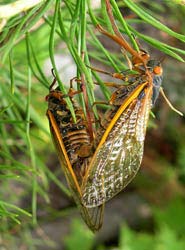Brood X cicadas will cause limited damage to trees, yard plants across eastern U.S.

Two cicadas mate during their brief above-ground reproductive period. <br>Copyright Holder: Chris Simon, University of Connecticut
The world’s largest insect emergence of “Brood X” cicadas in May will result in some damage to fruit trees and prized yard trees and shrubs, but the large insects will not cause crippling harm to common farm crops, an Indiana University scientist says.
“There will be some crop damage, especially to orchards, but we don’t expect a disaster,” said IU Bloomington biologist Keith Clay, who recently received a three-year, $300,000 National Science Foundation grant to study Brood X. “The cicadas don’t harm evergreen trees or leafy, non-woody plants. But isolated shrubs, broad-leafed trees, and trees with soft, woody branches are vulnerable. People who have just spent thousands of dollars on landscaping may want to consider throwing netting over the trees during the two-to-three-week period when the adult cicadas are out.”
Clay recommends that concerned gardeners, vintners and farmers place netting — with holes no greater than one-half inch across — securely over the top of vulnerable plants.
Brood X’s population is densest in southern Indiana, Kentucky and southwestern Ohio, but it has pockets in Illinois, Michigan, Tennessee, New Jersey, Missouri, northern Georgia, New York (Long Island), eastern Pennsylvania (including Philadelphia) and the Baltimore-Washington, D.C., metropolitan area.
Scientists expect Brood X cicadas to crawl out of the ground and begin the reproductive segment of their life cycle when soil temperatures reach 62 degrees Fahrenheit. While it’s hard to know just how many cicadas will appear in late May, Clay said the total number of emergent cicadas in the state of Indiana alone could reach the trillions.
Contrary to what one might expect, the population of 17-year periodical cicadas doesn’t cause much damage to trees and smaller plants by feeding on them. After more than 16 years of slowly sucking tree roots, Brood X cicadas arise from their subterranean chambers sated with most of the energy they’ll need to breed. Many adult cicadas don’t feed at all. Rather, the damage cicadas cause occurs when females use a special, razor-sharp appendage to cut open branches and twigs, into which they insert their fertilized eggs.
Clay hopes to dispel worries people may have about Brood X.
“Cicadas don’t bite, and they don’t attack people,” Clay said. “They are not very active when the sun goes down, so the massive noise we’ll hear in the daytime will subside, allowing people to sleep.”
In addition to filling knowledge gaps in scientists’ understanding of Brood X, Clay’s NSF project, which officially began March 1, will also explore the broader impacts of ecological disturbances on forests. Clay hopes to eventually secure long-term funding for the project, right up to Brood X’s next above-ground appearance in 2021.
“Given that Brood X is not going to emerge for another 17 years, this opportunity represents a once-in-a-researcher’s-lifetime opportunity to study the impacts of such an event,” said Michael Bowers, program director in NSF’s division of environmental biology, which funded the research. “This is the first study to experimentally determine the impact of cicada emergence, adult movement and their impact on woody plants. Cicadas are a major insect herbivore for which we have only limited information.”
Four other IUB scientists — geographer John Odland, biologist Heather Reynolds, geologist Greg Olyphant and anthropologist Emilio Moran — have also received NSF grants to study periodical cicadas in general or Brood X specifically.
Media Contact
More Information:
http://newsinfo.iu.edu/news/page/normal/1348.html?emailID=434All latest news from the category: Agricultural and Forestry Science
Newest articles

Superradiant atoms could push the boundaries of how precisely time can be measured
Superradiant atoms can help us measure time more precisely than ever. In a new study, researchers from the University of Copenhagen present a new method for measuring the time interval,…

Ion thermoelectric conversion devices for near room temperature
The electrode sheet of the thermoelectric device consists of ionic hydrogel, which is sandwiched between the electrodes to form, and the Prussian blue on the electrode undergoes a redox reaction…

Zap Energy achieves 37-million-degree temperatures in a compact device
New publication reports record electron temperatures for a small-scale, sheared-flow-stabilized Z-pinch fusion device. In the nine decades since humans first produced fusion reactions, only a few fusion technologies have demonstrated…





















